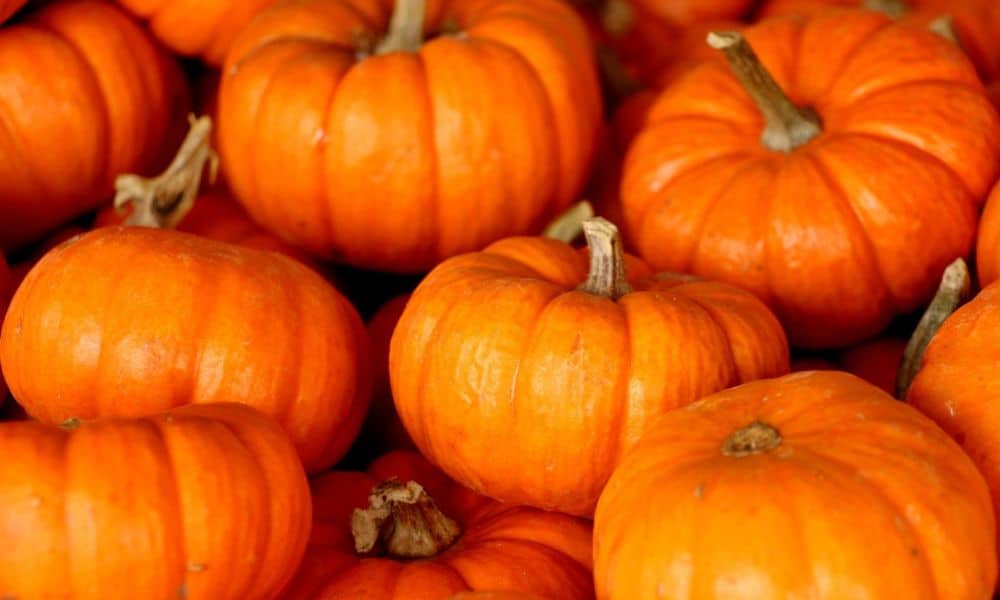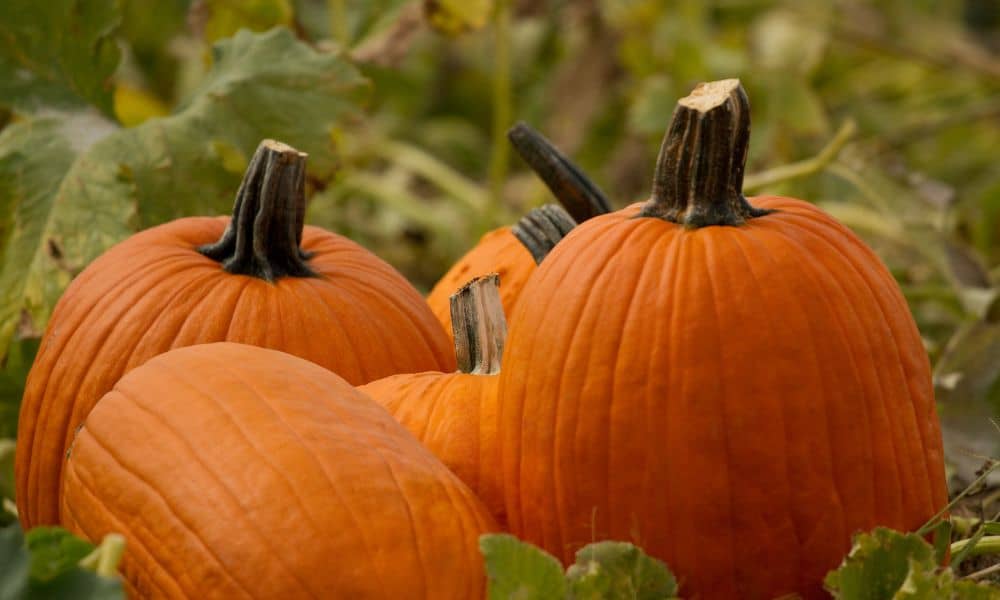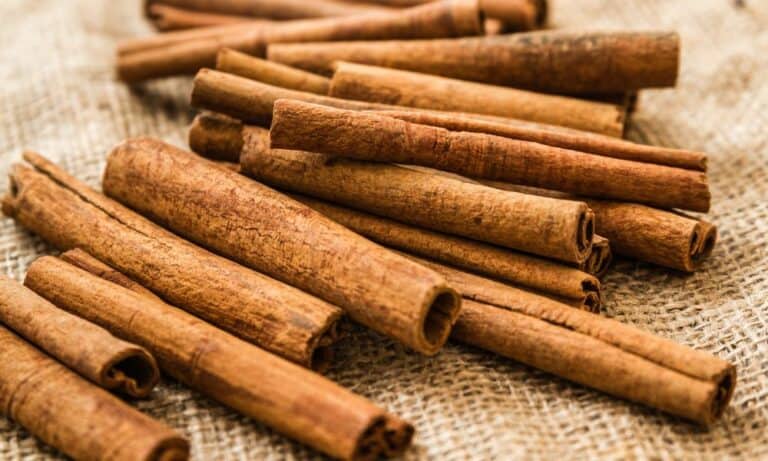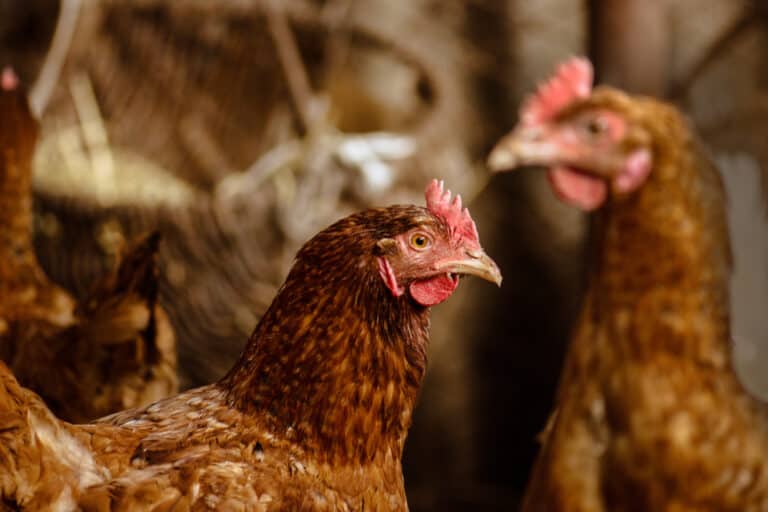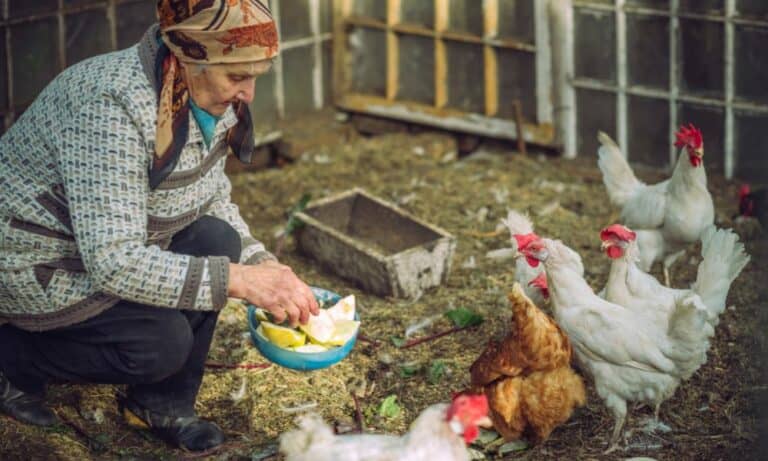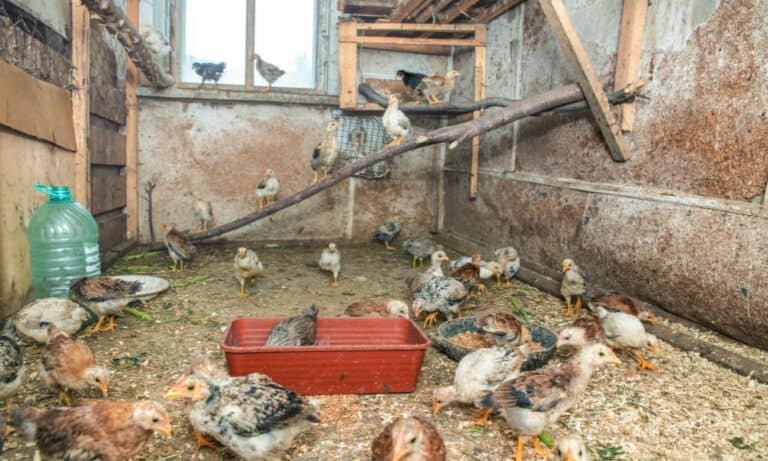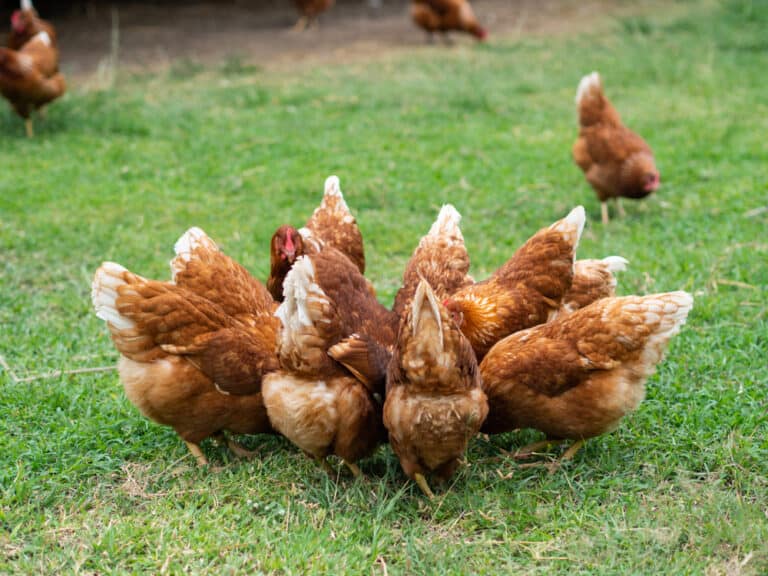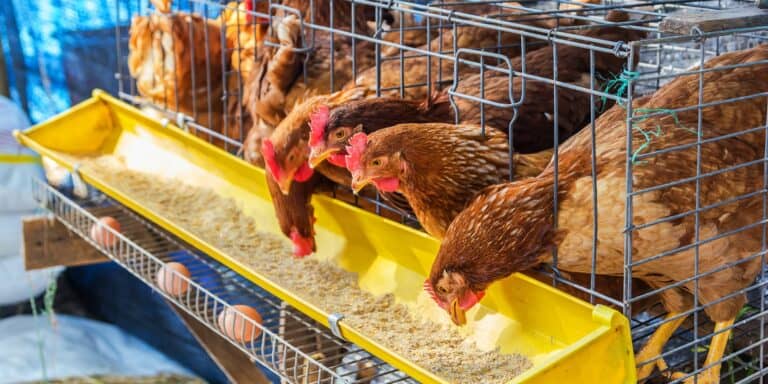The answer to the question of whether can chickens eat pumpkins is simple. Yes, they can, and they do it with particular pleasure. Besides being packed with vitamins and minerals, this fruit contains calcium and zinc crucial for laying hens.
Your chickens also adore pumpkin seeds, but you should avoid using this food as a treatment against worms. It is inefficient when used for this purpose. Making a puree of pumpkin flesh and freezing it makes this fruit an excellent treat for your poultry during cold winter months.
Nutrition content of 3.50 ounces (100 g) of pumpkins |
||
| Nutrients | Amount | Daily value for hens |
| Calories | 26 Kcal | 8% |
| Protein | 1 g | 5% |
| Fats | 0.1 g | / |
| Carbs | 6.5 g | / |
| Sugar | 2.76 g | 9% |
| Fiber | 0.5 g | / |
| Water | 91.6 g | / |
What are Pumpkins?
Pumpkins are a fruit developing from the flowering pumpkin vine. They typically weigh 9 to 18 pounds (4 – 8 kg) and have orange rinds with recognizable furrows. People use pumpkins as healthy food and often offer them to livestock or use them as Halloween decorations.
This fruit is native to the southern American States and northeastern Mexico. Scientists have confirmed that ancient nations used pumpkins from 7000 to 5500 BC. Besides cute small varieties and those of typical size, you can find giant ones weighing 75 pounds (34 kg).
The heaviest pumpkin weighing an unbelievable 2,703 pounds (1,226 kg), was grown in Tuscany, Italy. The US record-sized pumpkin reached 2,560 pounds (1,161 kg).
The best pumpkin types you can use to feed chickens are:
- Hokkaido pumpkin
- Munchkin pumpkin
- Jarrahdale pumpkin
- Big max pumpkin
- Long Island cheese pumpkin
- Baby boo pumpkin
- Fairytale pumpkin
- Jack O’ Lantern pumpkin
- Spaghetti squash
- Butternut squash
On the other hand, you should never feed your poultry with wild-growing pumpkins because they are tasteless and more or less bitter because of the cucurbitacin content. This toxic chemical may cause food poisoning in chickens.
Can Chickens Eat Pumpkins?
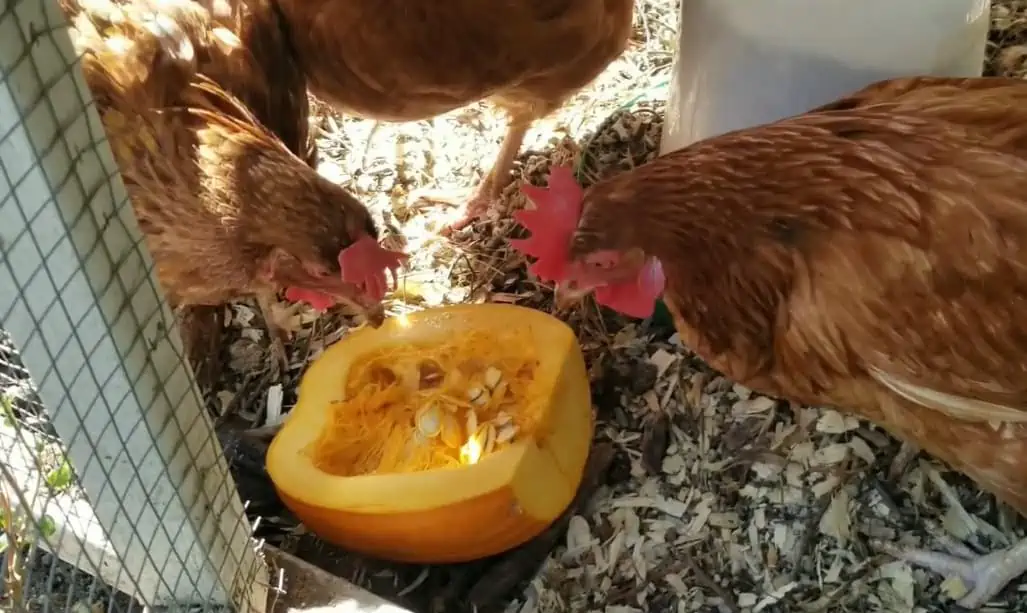
The advantage of pumpkins as chicken feed is that all their parts are edible, including their flesh, skin, stems, flowers, leaves, and seeds. Be careful when growing this fruit at places available to poultry because there is a chance to stay without fruit and foliage even when they are not fully ripe.
1. Pumpkin flesh
Most chickens adore consuming pumpkin flesh, but you should avoid offering this food regularly. Treating it as a treat and using it sparingly is a better option. It contains numerous nutrients, but not all the chicken body requires. Besides, some parts are hard to digest and may cause diarrhea.
Be particularly careful when feeding chicks with pumpkins because of their delicate digestive tract. Overfeeding may often cause an upset stomach. It is better to offer cooked and mashed pumpkin since it is softer than raw flesh and easier to chew, swallow, and digest.
There is an old belief that pumpkins can eliminate worms from poultry bodies. The truth is that the chemical cucurbitacin in pumpkin seeds may act like a natural dewormer in humans, horses, and goats, but there is no evidence it is the case with chickens.
2. Pumpkin skin
Chickens’ tastes vary, so some eat all pumpkin parts while others avoid its hard skin. The best option is to cut this fruit in half with intact skin and let your poultry choose what suits it. In some cases, chopping it into smaller pieces can be helpful.
The pumpkin skin benefits chickens thanks to its high vitamin and fiber content. Additionally, it is low in sugar, unlike the rest of its meat.
3. Pumpkin seeds
Most chickens adore pumpkin seeds and typically pick them out first. Since they contain micronutrients, antioxidants, and approximately 30% of healthy proteins and unsaturated fats, they are an incredibly desirable addition to the poultry diet.
Be careful never to overfeed chickens with seeds because they are high in fat. Considering them a treat and offering them in strictly dosed quantities is better.
Always serve grit with this feed to help your chickens break down seed cover and make swallowing easier. Besides feeding chickens with fresh pumpkin seeds, you can separate and dry them before storing them for the winter.
4. Pumpkin stems, leaves, and flowers
Chickens enjoy consuming squashes and green pumpkin parts, including foliage and flowers, but avoiding hard stems is better. Therefore, you should cut these parts and offer them to your fowl occasionally as a delicious addition to food.
However, always keep your poultry away from growing pumpkins. Be aware that damaging sensitive pumpkin vines cause fruit to dry and die.
Greenery is vital for boosting chicken’s immune system, thanks to high levels of minerals, like potassium, zinc, and iron, and vitamins, including vitamin A, C, and B complex. Unfortunately, they can be bitter, so some chickens dislike them.
If you want to offer pumpkin leaves and stalks to young chickens, getting rid of spines from their surface is advisable. Additional washing removes pesticides, dust, and remaining insects.
On the other hand, mildly sweet yellow pumpkin flowers are delicious, and you can offer them raw or cooked to chickens. They are an excellent source of vitamins A and C.
5. Pumpkin purée
You can make pumpkin purée by crushing its flesh and then serve it to your chickens as an edible and healthy treat. It is a favorite option of preparing for some owners since it makes storing it in the freezer more effortless. That way, poultry can enjoy this delicacy even during the winter.
6. Canned pumpkin
Processed pumpkins, like purée or canned fruit, have a high sugar content, preservatives, and additives, making them unhealthy for chickens. However, canned pumpkin can be an excellent food during the winter if you prepare it yourself or find a brand producing 100% pumpkin without carbs.
If pumpkin pieces are canned in syrup, pour the liquid off before offering the flesh to your poultry. Be careful if the syrup is sweet since the pumpkin has probably absorbed much of it. In such a case, proper dosage is the key to a healthy diet.
Ways to Feed Your Chickens with Pumpkins
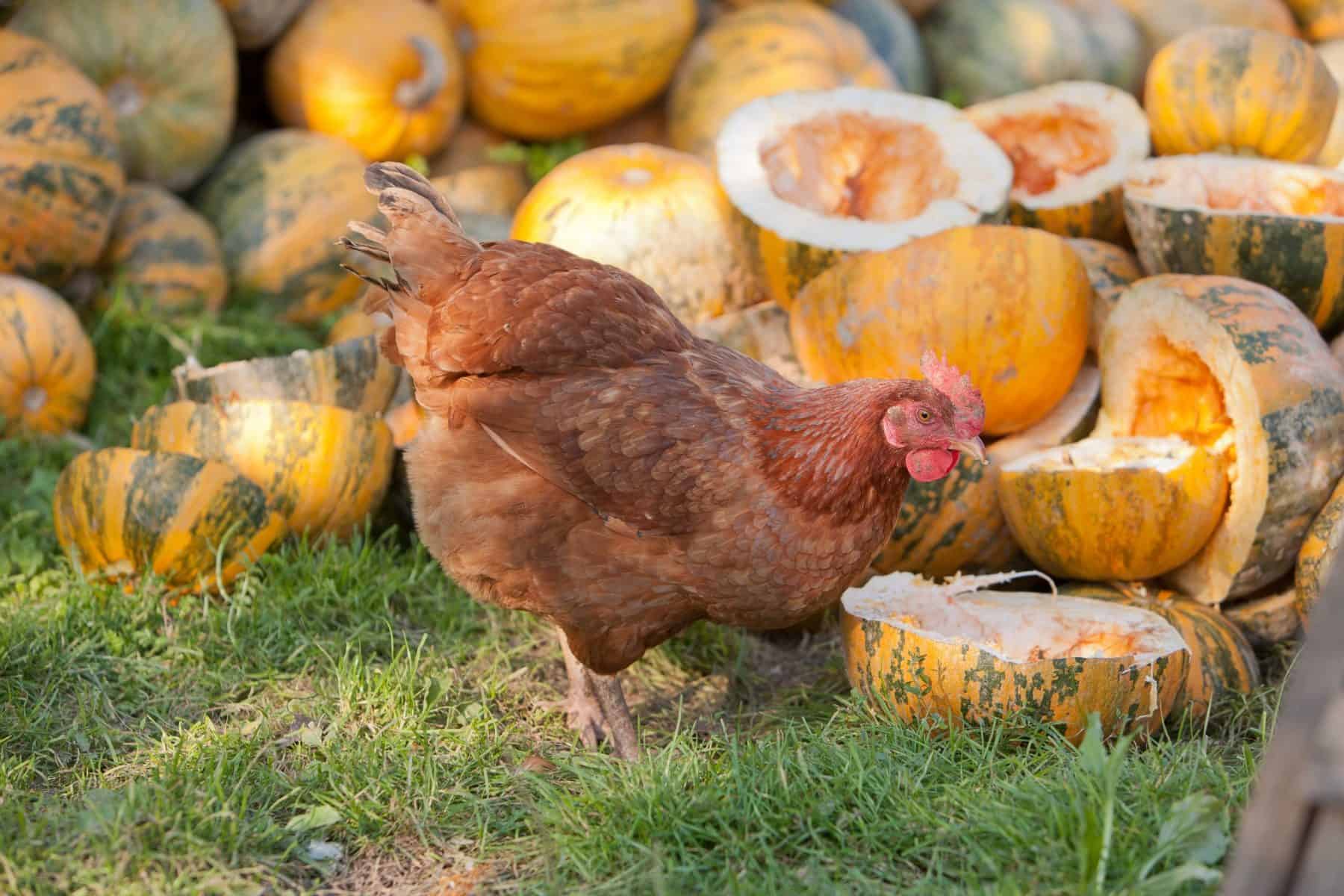
Chickens enjoy eating pumpkins, but you should never offer them in large quantities because they can make a diet unbalanced. However, this fruit is an excellent treat, particularly for laying hens, when limited to 5% of the daily food intake.
Avoid daily feeding your fowl with this food type but offer it occasionally. The best option is to let chickens enjoy fresh pumpkins during the season and freeze them for the winter period.
You can start with one pumpkin cut in half and see how many leftovers are there, letting you know how much is enough for your flock. Another option is to prepare tiny pieces or purée to make flesh more pleasurable for consumption. Never leave them overnight to prevent rodents from entering the chicken enclosure.
Pumpkins Nutritional Value
The health benefits of feeding pumpkins to chickens are numerous since they:
- Boost the immune system
- Keep the flock hydrated
- Help fowl to cool down during hot days
Besides, they are rich in essential nutrients necessary for proper chicken growth. For instance, pumpkin flesh is full of vitamin A typically insufficient in their regular diet. It plays a key role in maintaining good vision, improving feather growth, and supporting healthy egg production.
Content of vitamins and minerals in 3.50 ounces (100 g) pumpkin |
||
| Nutrients | Amount | The daily value for hens |
| Vitamin A | 426 µg | 280 % |
| Vitamin E | 1 mg | 8% |
| Vitamin C | 9 mg | 9% |
| Thiamin | 0.05 mg | / |
| Riboflavin | 0.11 mg | / |
| Pantothenic acid | 0,298 mg | 3% |
| Pyridoxine | 61 µg | 2% |
| Folates | 16 µg | 1.5% |
| Vitamin K | 1.1 µg | / |
| a-carotene | 4,016 µg | / |
| b-carotene | 3,100 µg | / |
| Lutein and zeaxanthin | 1,500 µg | / |
| Calcium | 21 mg | 0.6% |
| Phosphorus | 44 mg | / |
| Magnesium | 12 mg | / |
| Potassium | 340 mg | / |
| Sodium | 1 mg | / |
| Manganese | 0.125 mg | / |
| Copper | 0.127 mg | / |
| Iron | 0.8 mg | / |
| Zinc | 0.32 mg | / |
| Selenium | 0.3 µg | / |
Vitamin E content boosts the immune system and helps heal chickens suffering from bronchitis, coccidiosis, and Escherichia coli. Since this fruit is packed with fibers, you can use it as an excellent low-calorie snack, preventing overweight.
Additionally, a high potassium level is crucial for hens, particularly a few weeks before you decide to collect hatching eggs. Zinc from pumpkins speeds up the shell membrane formation.
Finally, pumpkins are an excellent source of trace elements and antioxidants, like a-carotene, b-carotene, lutein, lycopene, and zeaxanthin. All support the flock’s health, making this treat a valuable part of its diet.
Unfortunately, feeding pumpkins to chickens can be harmful if you offer improperly washed, rotten, or moldy fruit. You should also avoid mixing it with unhealthy table leftovers.
Summary
Pumpkins are an excellent treat for chickens, but you shouldn’t offer them instead of regular feed. Moderate amounts added to their meals make them well-balanced and highly nutritious. This fruit is yummy, and poultry enjoys nibbling it. Besides, its seeds, packed with essential fatty acids, vitamin E, and zinc, are highly beneficial and healthy.

